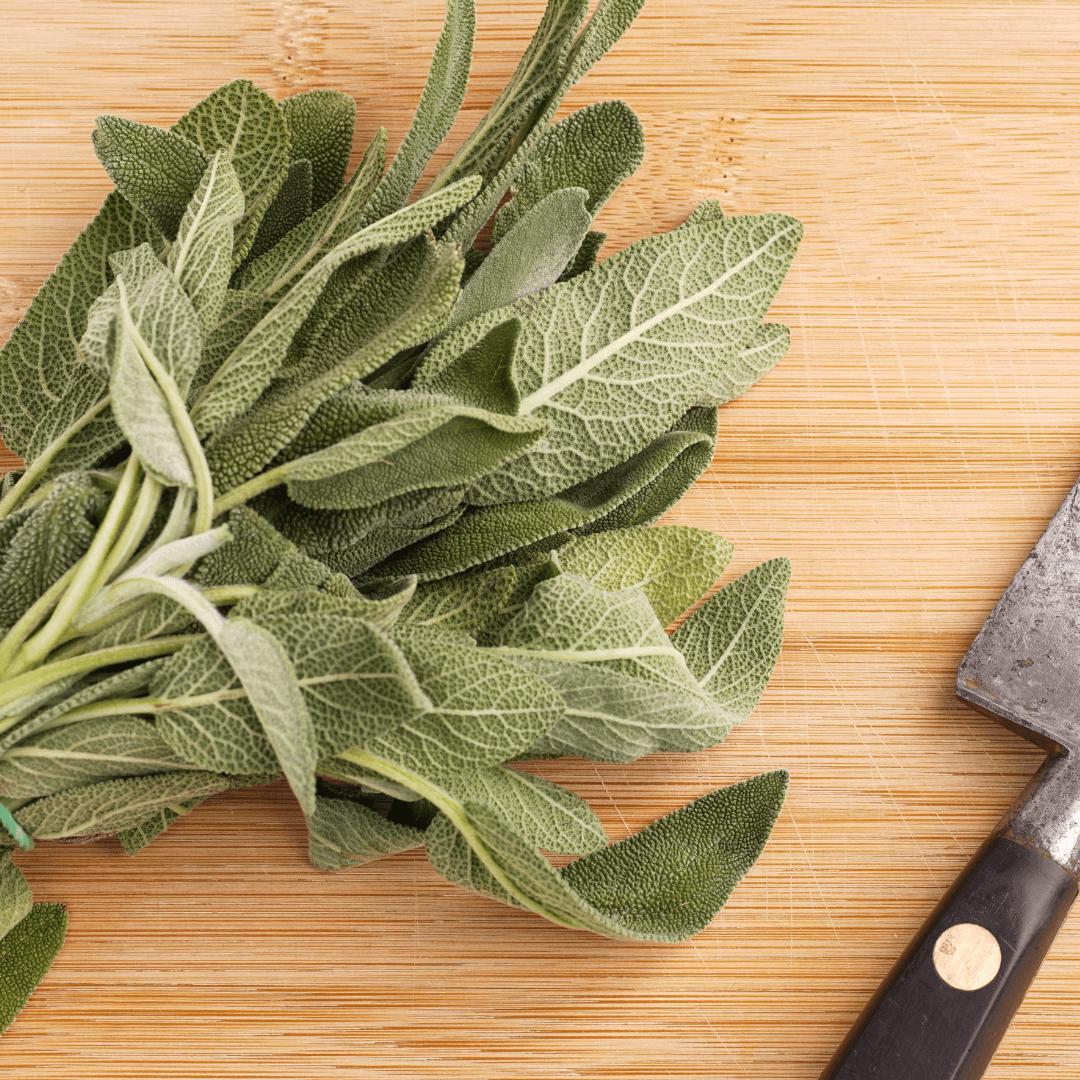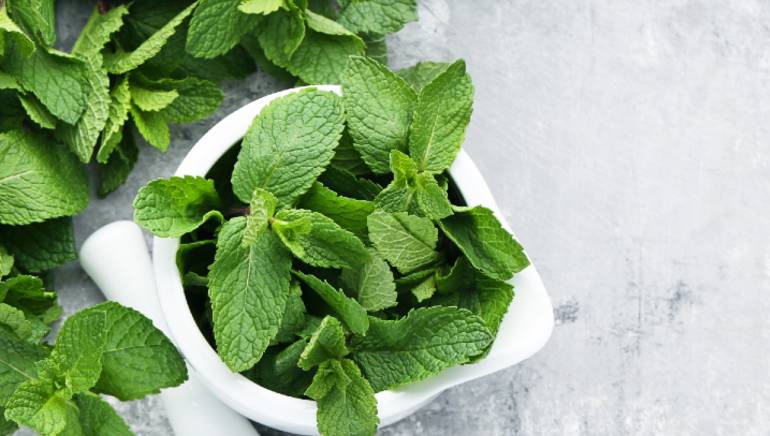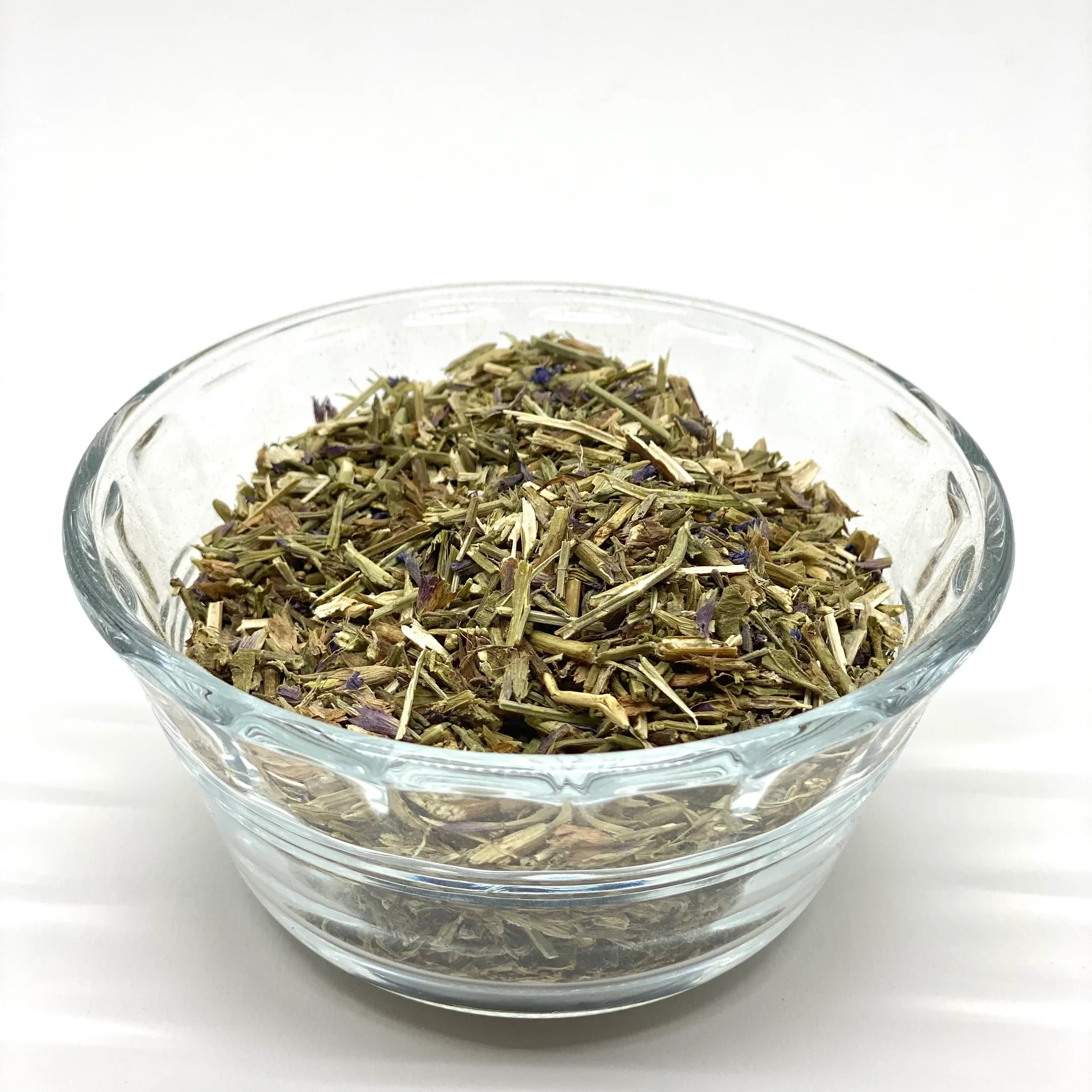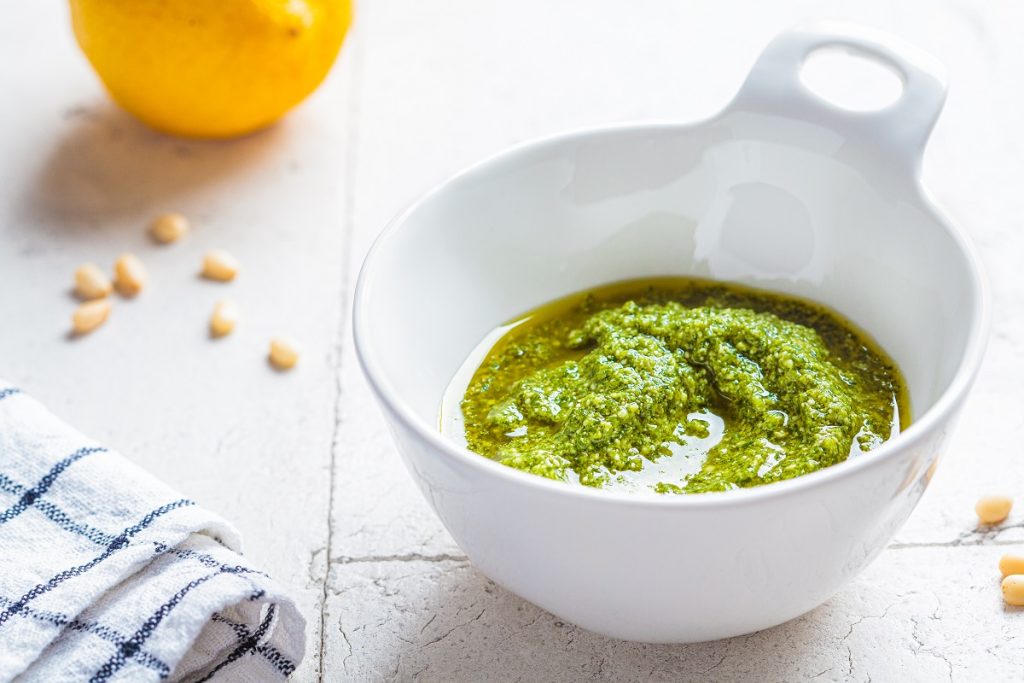
Reducing salt intake has become a popular goal for many who want to improve their health while still enjoying flavorful meals. While salt enhances taste, too much of it can pose risks like high blood pressure, heart disease, and kidney issues.
Herbs offer a natural, aromatic way to bring depth and complexity to dishes, providing vibrant flavors that make meals satisfying without the need for extra sodium. This guide will show you how to use herbs instead of salt, helping you enhance your dishes while embracing a healthier approach to seasoning.
1. Basil
- Benefits: Basil is a powerhouse of antioxidants, including vitamins A, C, and K, which help support immune health, skin health, and bone strength. It also has anti-inflammatory properties, making it beneficial for reducing inflammation and providing digestive support.
- Taste: Basil has a sweet, peppery flavor with a hint of mint and clove. This herb brings a fresh and slightly spicy aroma, often described as uplifting and cooling.
- Uses in Cooking: Basil shines in Italian and Mediterranean cuisines, where it often replaces salt in classic dishes. Use fresh basil in salads, particularly with tomatoes and mozzarella, to create flavor without any added sodium. In sauces, basil can be blended into pestos, added to pasta sauces, or used to flavor roasted vegetables. Basil’s sweet, peppery notes make it an excellent addition to soups, especially tomato-based soups, where it creates a balanced flavor profile without relying on salt. Incorporating herbs for flavorlike basil not only enhances dishes but also promotes healthier eating habits by reducing sodium intake.
2. Thyme
- Benefits: Thyme is rich in vitamins C and A, along with several essential minerals like manganese and iron. Known for its antibacterial and antimicrobial properties, thyme can help boost immunity and is often used in natural remedies for respiratory health.
- Taste: With a warm, earthy flavor that includes hints of mint and lemon, thyme adds a layer of complexity and depth to savory dishes.
- Uses in Cooking: Thyme is incredibly versatile and pairs well with a variety of ingredients. Use it in soups and stews to add depth to the broth, as the herb slowly releases its flavor during cooking. Thyme is a great addition to roasted vegetables like carrots, potatoes, and parsnips, as it adds a rich, savory element without requiring salt. For meat dishes, especially chicken, lamb, or beef, thyme complements the flavors and creates a well-rounded seasoning profile.
3. Rosemary
- Benefits: Rosemary is high in antioxidants and has anti-inflammatory and antimicrobial properties. It’s been linked to improved digestion and circulation, as well as enhanced concentration and memory.
- Taste: Rosemary has a strong, pine-like aroma with a slightly bitter, resinous flavor that pairs well with hearty dishes.
- Uses in Cooking: Rosemary’s bold flavor is ideal for salt-free cooking, as it adds a rich aromatic quality. It works well in roasted meats like lamb, chicken, and pork, where its intense aroma permeates the dish. For vegetables, rosemary is excellent with potatoes, carrots, and squash, especially when roasted. It’s also a great addition to bread recipes, such as focaccia, where it brings a robust flavor to the dough. To make a salt-free seasoning, try infusing olive oil with rosemary, garlic, and lemon zest for a delicious flavor enhancer.
4. Oregano
- Benefits: Oregano is packed with antioxidants, particularly carvacrol and thymol, which help support immune function and have strong antibacterial effects. It also contains fiber, iron, and manganese, supporting overall wellness.
- Taste: With a bold, slightly peppery taste and a hint of bitterness, oregano is highly aromatic and brings an earthy, savory quality to dishes.
- Uses in Cooking: Oregano is popular in Italian and Mediterranean dishes and is often used in sauces, marinades, and dressings. It pairs beautifully with tomatoes, garlic, and olive oil, making it a natural choice for pasta sauces and pizza toppings. Oregano can also enhance grilled or roasted vegetables, adding a savory depth without needing salt. In Greek cuisine, oregano is often combined with lemon juice and olive oil to marinate meats, creating a flavorful dish that doesn’t rely on sodium. To keep your oregano fresh for longer, consider how to store fresh herbsproperly; this ensures you have this versatile ingredient on hand whenever you need it.
5. Dill
- Benefits: Dill is a good source of vitamin C, manganese, and flavonoids, which provide antioxidant and anti-inflammatory benefits. Dill is known to support digestion and may help alleviate bloating and gas.
- Taste: Dill has a light, tangy flavor with slightly sweet and grassy undertones, bringing a bright, refreshing taste to dishes.
- Uses in Cooking: Dill is particularly suited for fish and seafood dishes, where it complements the natural flavors without overpowering them. It’s also a popular addition to salads, yogurt-based dressings, and creamy sauces, providing a fresh flavor without salt. Try adding fresh dill to potato salads, cucumber salads, or tzatziki. For a quick salt-free boost, sprinkle dill over steamed or roasted vegetables like carrots, zucchini, or asparagus.
6. Sage
- Benefits: Sage contains antioxidants and anti-inflammatory compounds that may improve brain health and memory. It’s also known for supporting digestion and has antimicrobial effects that make it a popular choice in herbal remedies.
- Taste: Earthy, slightly peppery, and mildly bitter, sage has a strong flavor that stands out in hearty, savory dishes.
- Uses in Cooking: Sage is a fantastic herb for fall and winter dishes. It pairs beautifully with poultry and pork, adding depth to dishes like roasted turkey, chicken, or pork tenderloin. Sage is also commonly used in stuffing and complements root vegetables like sweet potatoes, squash, and carrots. To enhance pasta dishes without salt, try making a sage-infused butter sauce, which brings a warm, nutty flavor to the meal.
7. Parsley
- Benefits: Parsley is packed with vitamins A, C, and K, making it great for skin, eye, and bone health. It also contains antioxidants and has been shown to support kidney function and reduce inflammation.
- Taste: Mild, fresh, and slightly peppery, parsley adds a clean, bright flavor that enhances other ingredients without overwhelming them.
- Uses in Cooking: Parsley is one of the most versatile herbs and can be used as a garnish or as a primary flavor component. Use it in salads, soups, and sauces to add a fresh, vibrant taste without salt. It’s a staple in dishes like tabbouleh and chimichurri, where it provides a green, zesty flavor. Sprinkle chopped parsley over roasted vegetables, pasta dishes, and grain bowls for a finishing touch that adds both flavor and color.
8. Cilantro
- Benefits: Cilantro is rich in antioxidants, including vitamin K, which supports bone health, and vitamin C, which boosts the immune system. It’s also known for its detoxifying properties.
- Taste: Cilantro has a bright, citrusy flavor with a slightly peppery undertone, adding a refreshing note to dishes.
- Uses in Cooking: Cilantro is commonly used in Mexican, Indian, and Thai cuisines, bringing a unique flavor that enhances the dish. Add it to salsas, guacamole, curries, and salads for a vibrant, salt-free boost. It also pairs well with lime juice, adding a natural brightness to tacos, stir-fries, and marinades. For a quick, flavorful garnish, sprinkle fresh cilantro over soups or rice dishes.
9. Tarragon
- Benefits: Tarragon is a source of antioxidants and has anti-inflammatory properties. It’s also known to aid in digestion and reduce bloating.
- Taste: Tarragon has a mild, sweet licorice-like flavor with hints of anise, providing a subtle but distinct taste.
- Uses in Cooking: Tarragon works well in French-inspired dishes, particularly in creamy sauces and dressings. It’s a natural match for chicken, seafood, and egg dishes, bringing a slight sweetness that offsets the need for salt. Add tarragon to béarnaise sauce, vinaigrettes, or scrambled eggs for an elegant flavor boost. It also pairs well with mushrooms and asparagus, bringing out their natural flavors without additional seasoning.
10. Marjoram
- Benefits: Marjoram has anti-inflammatory and antimicrobial properties and is high in antioxidants. It supports digestive health and may help relieve muscle and joint pain.
- Taste: Similar to oregano but milder and sweeter, marjoram has an earthy, floral flavor with a hint of citrus.
- Uses in Cooking: Marjoram is ideal for Italian and Mediterranean dishes, particularly roasted meats and vegetables. It can replace salt in dishes like soups, stews, and sauces, adding a subtle, savory note. Marjoram works well in bean dishes and pairs beautifully with chicken, lamb, and even fish. Add it to salad dressings or sprinkle over roasted vegetables for a gentle, fragrant flavor.
11. Chives
- Benefits: Chives are high in vitamins A, C, and K and contain antioxidants that support immune function and skin health.
- Taste: Chives have a mild onion-like flavor that adds a hint of sharpness without overpowering dishes.
- Uses in Cooking: Chives are versatile and work well in salads, eggs, and creamy dips. Add chopped chives to mashed potatoes, scrambled eggs, or soups for a subtle, fresh flavor without salt. They also work as a garnish, adding color and taste to dishes like baked potatoes, omelets, and even cold pasta salads.
12. Bay Leaves
- Benefits: Bay leaves are known for their anti-inflammatory and antioxidant properties and are commonly used to aid digestion.
- Taste: Bay leaves have a subtle, slightly bitter taste that imparts a woody, savory flavor to dishes.
- Uses in Cooking: Bay leaves are ideal for long-simmering dishes like soups, stews, and sauces. Add one or two leaves to broths, rice dishes, or slow-cooked meats for a mild flavor that deepens as it cooks. Remember to remove the leaves before serving, as they are not meant to be eaten.
13. Mint
- Benefits: Mint is known for its high levels of vitamins A and C, along with its antioxidant properties. It aids digestion, helps reduce bloating, and can freshen breath naturally.
- Taste: Mint has a refreshing, cool flavor that can add a bright, zesty element to both savory and sweet dishes.
- Uses in Cooking: Mint is excellent for adding a fresh taste to salads, yogurt sauces, and drinks. It pairs especially well with lamb, adding a cooling contrast to rich flavors. Try adding fresh mint to fruit salads, cucumber salads, or blend it into smoothies for a bright, salt-free boost. Mint also complements pea soups, tzatziki, and desserts, where it creates a refreshing finish.
14. Lemongrass
- Benefits: Lemongrass is rich in antioxidants and has anti-inflammatory properties. It’s commonly used for digestive support and is believed to have calming effects.
- Taste: With a citrusy, slightly floral aroma, lemongrass adds brightness and zest to dishes, making it an excellent salt alternative.
- Uses in Cooking: Lemongrass is widely used in Southeast Asian cuisines, especially Thai, to add a lemony, aromatic depth to soups, curries, and marinades. Use lemongrass in coconut-based curries, noodle dishes, and herbal teas. When combined with ginger and garlic, it creates a complex base for stir-fries and broths that doesn’t need salt for flavor.
15. Chervil
- Benefits: Chervil is high in vitamins A and C and contains antioxidants. It’s often used to support digestion and reduce inflammation.
- Taste: Chervil has a delicate, mild flavor similar to parsley with hints of anise, making it a subtle but flavorful addition to dishes.
- Uses in Cooking: Chervil is popular in French cuisine and is often used in light sauces, soups, and salads. Add it to egg dishes, seafood, and vinaigrettes for a gentle herbal note that enhances without overpowering. Chervil is best used fresh and works well as a garnish for delicate dishes like fish or steamed vegetables.
16. Summer Savory
- Benefits: Summer savory contains antibacterial properties and is a good source of fiber and antioxidants. It’s known to aid in digestion and relieve gas and bloating.
- Taste: Peppery with a hint of thyme, summer savory brings a warm, earthy flavor that adds depth to dishes.
- Uses in Cooking: Summer savory is particularly popular in bean dishes, where it enhances the natural flavor of legumes without requiring salt. It’s also used in poultry, pork, and vegetable dishes. Try adding it to stuffing, stews, or sauces to replace salt with a bold, savory taste. Summer savory works well in lentil soups and is often used to flavor sausages in salt-free recipes.
17. Fennel
- Benefits: Fennel is high in fiber, potassium, and vitamin C. It’s known for its digestive benefits and anti-inflammatory properties.
- Taste: With a mild anise or licorice-like flavor, fennel adds a unique sweetness and depth that’s ideal for salt-free seasoning.
- Uses in Cooking: Fennel works well in Mediterranean and Italian dishes. Use fennel seeds to flavor roasted meats or vegetables, and add fresh fennel to salads for a crunchy, aromatic element. Fennel pairs well with fish, pork, and in soups, where it brings out other flavors naturally. In salads, it adds a refreshing crispness that complements citrus fruits and greens.
18. Lovage
- Benefits: Lovage is a source of vitamins C and B complex, along with minerals like potassium and calcium. It has antioxidant properties and supports digestion.
- Taste: Lovage has a strong celery-like flavor with hints of anise, making it a savory herb that mimics the saltiness of celery salt.
- Uses in Cooking: Lovage is ideal for soups, stews, and stocks, where it enhances the flavor profile without salt. It can also be used in potato dishes, salads, and marinades. Add lovage to homemade broths, lentil soups, or sprinkle it on roasted potatoes for a savory boost.
19. Celery Leaves
- Benefits: Celery leaves contain vitamins A and C, along with antioxidants that promote immune health and reduce inflammation.
- Taste: Similar to the celery stalk, celery leaves offer a fresh, slightly bitter flavor that’s mild yet impactful.
- Uses in Cooking: Celery leaves are great in soups, stews, and salads as a salt substitute. Use them in place of parsley for a slightly different taste, or add them to smoothies for an extra nutrient boost. Celery leaves work well in chicken or vegetable broths, where they add a subtle depth without needing added sodium.
20. Fenugreek
- Benefits: Fenugreek is high in fiber and iron and is known for supporting digestion, reducing inflammation, and regulating blood sugar levels.
- Taste: Fenugreek has a slightly bitter, nutty flavor with hints of maple, making it a unique addition to dishes.
- Uses in Cooking: Fenugreek is commonly used in Indian and Middle Eastern cooking, especially in curries, lentil dishes, and spice blends. Add fenugreek leaves to stews and meat dishes for a subtle salt alternative or use fenugreek seeds to infuse sauces and soups with a rich, earthy flavor.
21. Curry Leaves
- Benefits: Curry leaves are rich in antioxidants and vitaminsA, B, and C. They support heart health, aid digestion, and help regulate blood sugar.
- Taste: Slightly bitter and nutty, curry leaves add a unique aroma and taste, often associated with Indian cuisine.
- Uses in Cooking: Curry leaves are typically fried in oil to release their flavor and then added to dishes like dals, curries, and stews. Use curry leaves in rice dishes or coconut-based sauces for a hint of exotic spice that replaces salt. They pair well with mustard seeds, turmeric, and chilies, making them a powerful addition to flavor bases.
22. Epazote
- Benefits: Epazote is high in fiber and vitamins, and it’s traditionally used in Mexican cuisine to support digestion and reduce gas, especially in bean dishes.
- Taste: Epazote has a strong, slightly medicinal flavor with earthy undertones, adding a distinctive herbal taste.
- Uses in Cooking: Epazote is commonly used in Mexican dishes, particularly with beans, to enhance flavor and aid digestion. Add a few leaves to bean soups or stews for an earthy twist. Its unique taste can be polarizing, so use it sparingly for a subtle, salt-free accent.
23. Lemon Balm
- Benefits: Lemon balm contains antioxidants and may support mood and digestion. It’s also known for its calming effects.
- Taste: Lemon balm has a mild lemony taste with a hint of mint, making it a refreshing addition to both savory and sweet dishes.
- Uses in Cooking: Lemon balm is ideal for fish, chicken, and salads. Use it fresh in marinades or add it to beverages like tea for a citrusy lift. It’s also delicious in fruit salads and desserts, adding a subtle brightness that replaces the need for salt.
24. Hyssop
- Benefits: Hyssop is known for its respiratory benefits and has anti-inflammatory and antioxidant properties.
- Taste: Hyssop has a minty, slightly bitter flavor that’s earthy and aromatic, adding complexity to dishes.
- Uses in Cooking: Use hyssop in soups, stews, and meat dishes. It works well with lamb and poultry, where its strong flavor complements the richness of the meat. Add it to marinades or herb rubs for a distinctive, savory profile without needing salt.
25. Sorrel
- Benefits: Sorrel is rich in vitamin C, iron, and antioxidants, which support immune health and reduce inflammation. It also has mild diuretic properties and aids in digestion, making it a great choice for a health-conscious diet.
- Taste: Sorrel has a tangy, lemon-like flavor with a hint of bitterness, adding a refreshing and slightly acidic note to dishes. Its bright taste can mimic the role of citrus, providing a natural brightness to recipes.
- Uses in Cooking: Sorrel is excellent in salads, soups, and sauces, where it can replace the need for both salt and acidic ingredients like lemon. In salads, sorrel pairs well with greens, adding a zesty punch when mixed with spinach or arugula. For soups, try adding sorrel at the end of cooking to preserve its vibrant color and fresh taste; it works especially well in creamy or potato-based soups.
26. Perilla (Shiso)
- Benefits: Perilla, also known as shiso, is high in antioxidants and contains omega-3 fatty acids, which support heart health. It also has anti-inflammatory and antibacterial properties.
- Taste: Perilla has a complex flavor that combines mint, basil, anise, and citrus notes, creating a bold and unique taste.
- Uses in Cooking: Popular in Japanese and Korean cuisines, perilla is used in sushi, salads, and wraps. It adds a fresh, herbaceous flavor to rice dishes, soups, and grilled meats. Perilla leaves can be used as a wrapper for cooked meats or as a garnish, enhancing dishes with a burst of flavor that makes salt unnecessary. If you're looking for ways to incorporate this herb into your meals, you might find some easy dinner recipesthat highlight its unique taste and versatility.
27. Borage
- Benefits: Borage is a good source of omega-6 fatty acids and contains vitamins A and C, supporting skin health and reducing inflammation.
- Taste: Borage has a mild cucumber flavor, which brings a cool, refreshing taste to dishes.
- Uses in Cooking: Borage is often used fresh in salads, soups, and cold drinks. Its cucumber-like taste complements summer salads, where it can be paired with tomatoes, cucumbers, and vinaigrettes. Borage flowersare also edible and make a beautiful, flavorful garnish. Use borage in smoothies or as a garnish for chilled soups to add a light, refreshing note.
28. Lemon Verbena
- Benefits: Lemon verbena is known for its high levels of antioxidants and vitamin C. It has calming effects and supports digestion, making it a popular choice in herbal teas.
- Taste: Lemon verbena has a strong lemony aroma with a bright, citrusy flavor that’s less acidic than actual lemon.
- Uses in Cooking: Lemon verbena is a versatile herb that can be used in both sweet and savory dishes. It works well with poultry and fish, where its citrus notes add a fresh touch without needing salt. Add it to marinades, salad dressings, and sauces for a zesty flavor. In desserts, lemon verbena complements fruit salads, sorbets, and baked goods, adding a light, lemony fragrance.
Specific Cooking Techniques To Enhance Herb Flavors
These techniques will help you get the most flavor from herbs, allowing them to stand in for salt with ease.
1. Infusing Oils
Herb-infused oils are an excellent way to add subtle flavor to dishes without salt. Simply add sprigs of rosemary, basil, or thyme to olive oil and let it infuse for a few days. Drizzle this oil over roasted vegetables, salads, or pasta for a fragrant, salt-free finish.
2. Making Herb Blends
Creating your own herb blends, such as Italian or Mediterranean mixes, allows you to add complex flavor with one sprinkle. Combine herbs like oregano, basil, thyme, and rosemary for an Italian blend, or mix mint, dill, and parsley for a Mediterranean touch. Store your blend in an airtight container for easy use.
3. Herb-Infused Vinegars
Herb-infused vinegars offer a tangy, aromatic alternative to salt. Simply add fresh herbs to a jar of vinegar (white, red wine, or apple cider) and let it sit for 1–2 weeks. Use the flavored vinegar in dressings, marinades, or as a seasoning for cooked vegetables.
4. Using Citrus And Herbs Together
Combining herbs with citrus zest or juice brightens up dishes and can replace salt effectively. Try lemon and thyme on fish, or orange zest with rosemary for poultry. The citrus adds a fresh acidity that enhances the herb’s natural flavor.
Why Reduce Salt?
Excessive salt intake is linked to various health problems, including hypertension and cardiovascular disease. Reducing salt not only benefits blood pressure but also supports kidney health and may reduce the risk of stroke. As many people seek healthier dietary habits, cutting back on salt has become a top priority.
Using herbs in place of salt offers a flavor-packed alternative, with herbs containing natural antioxidants, vitamins, and minerals that benefit the body. Basil, rosemary, thyme, and other herbs not only add freshness but also contain anti-inflammatory properties that support overall wellness. Switching from salt to herbs in cooking can bring out the best flavors in food, creating complex taste profiles that highlight the natural goodness of each ingredient.
FAQs
What Are The Best Herbs To Use As A Salt Substitute?
Herbs like basil, thyme, rosemary, oregano, and dill are excellent salt substitutes. They add depth, aroma, and complexity to dishes, enhancing flavor naturally without needing salt.
Can Herbs Completely Replace Salt In Cooking?
Yes, herbs can replace salt in most recipes, though it may take time for your taste buds to adjust. Fresh and dried herbs offer complex flavors that can make up for the missing saltiness, especially when used creatively with other seasonings.
How Do I Store Fresh Herbs To Keep Them Flavorful?
Fresh herbs should be stored in the refrigerator, either wrapped in a damp paper towel or placed upright in a glass of water. This helps them stay fresh longer and retain their full flavor.
Are Dried Herbs As Effective As Fresh Herbs In Replacing Salt?
Dried herbs can be just as effective, especially in long-cooked dishes like soups and stews. They have a more concentrated flavor, so use them sparingly. Generally, 1 teaspoon of dried herbs equals 1 tablespoon of fresh.
What Dishes Are Best For Using Herbs Instead Of Salt?
Herbs work well in a variety of dishes, including soups, stews, salads, marinades, and roasted vegetables. For example, rosemary and thyme are excellent in roasted meats, while basil and oregano are great in Italian dishes.
Final Thoughts
Switching from salt to herbs can transform the way you experience flavors in your cooking, bringing out the natural tastes of each ingredient while also supporting a healthier lifestyle. Each herb in this list offers unique flavors and benefits, from the refreshing brightness of mint to the deep, earthy notes of sage.
By incorporating these herbs, you’re not only cutting back on sodium but also enhancing the complexity and depth of your dishes. Experimenting with herbs opens a world of culinary possibilities.



























